 www.U-35.com
www.U-35.comThe Homepage for U-35, a Type VII U-Boat
... 1936 - 1939 ...
 www.U-35.com
www.U-35.comThe Homepage for U-35, a Type VII U-Boat ... 1936 - 1939 ... |
|
|
|
|
|
|
|
U-35 crew member
Siegfried Bruse
Seeking any additional information
and pictures related to U-35
Siegfried Bruse was born on 16 October 1917 in Mecklenburg, Germany.
 Johann
van der Pütten,
Walter Roloff and Siegfried Bruse underway on
U-35. [47]
Johann
van der Pütten,
Walter Roloff and Siegfried Bruse underway on
U-35. [47]
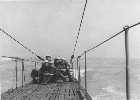 Walter Roloff, Paul Fichte,
Siegfried Bruse, Peter Schwarz, and
Johann van der Pütten underway on U-35. [56]
Walter Roloff, Paul Fichte,
Siegfried Bruse, Peter Schwarz, and
Johann van der Pütten underway on U-35. [56]
 U-35 in the Spanish port city of Cadiz during the Spanish Civil
War.
Johann van der Pütten, Karl Schnute, Peter Schwarz,
Paul Fichte, Karl Sommerer,
Siegfried Bruse. [47]
U-35 in the Spanish port city of Cadiz during the Spanish Civil
War.
Johann van der Pütten, Karl Schnute, Peter Schwarz,
Paul Fichte, Karl Sommerer,
Siegfried Bruse. [47]
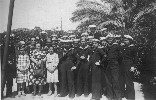
![]() The crew of U-35 in Spain. [44]
Siegfried Bruse is in the front row without a hat.
The crew of U-35 in Spain. [44]
Siegfried Bruse is in the front row without a hat.
 Crewmembers of U-35 on the shore in Spain: Siegfried Bruse,
Willi Jacob, and
Theodor Schütt [44]
Crewmembers of U-35 on the shore in Spain: Siegfried Bruse,
Willi Jacob, and
Theodor Schütt [44]
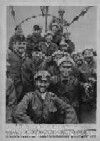
 The crew of U-35, including Siegfried Bruse, upon return from
the first war patrol. [33,cover photo of 32]
The crew of U-35, including Siegfried Bruse, upon return from
the first war patrol. [33,cover photo of 32]
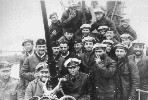
 Another photograph taken of the U-35 crew, including Siegfried
Bruse, upon return from the first war cruise. [35]
Another photograph taken of the U-35 crew, including Siegfried
Bruse, upon return from the first war cruise. [35]
 Part
of the crew of U-35, now prisoners of war, arriving at a Scottish
port on board HMS KASHMIR, 01 December 1939. The original caption to
this wartime magazine photo read: "Most of the forty-three prisoners
expressed distaste at their task of sinking defenceless ships and seemed
glad that their share in this type of warfare is finished." Pictured:
Ernst Weber, Siegfried Kienast,
Gerhard Freier, Wilhelm Janssen,
Siegfried Bruse, Johann van der Pütten,
Martin Müller, Karl Sommerer. [19,33,38]
Part
of the crew of U-35, now prisoners of war, arriving at a Scottish
port on board HMS KASHMIR, 01 December 1939. The original caption to
this wartime magazine photo read: "Most of the forty-three prisoners
expressed distaste at their task of sinking defenceless ships and seemed
glad that their share in this type of warfare is finished." Pictured:
Ernst Weber, Siegfried Kienast,
Gerhard Freier, Wilhelm Janssen,
Siegfried Bruse, Johann van der Pütten,
Martin Müller, Karl Sommerer. [19,33,38]
 Part
of the crew of U-35 arriving at a Scottish port on board HMS
KASHMIR. Front row: Johannes Weigand,
Siegfried Bruse, Martin Müller,
Karl Sommerer, Theodor Schütt,
Albert Schrader, Kurt Grosser, and
Paul Fichte
[33,38]
Part
of the crew of U-35 arriving at a Scottish port on board HMS
KASHMIR. Front row: Johannes Weigand,
Siegfried Bruse, Martin Müller,
Karl Sommerer, Theodor Schütt,
Albert Schrader, Kurt Grosser, and
Paul Fichte
[33,38]
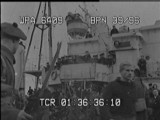 Siegfried Bruse, lower right, departing HMS KASHMIR in Glasgow,
Scotland.
Siegfried Bruse, lower right, departing HMS KASHMIR in Glasgow,
Scotland.
Upon capture, Siegfried Bruse was assigned POW Number 37325.
Siegfried Bruse remembered the train trip across Canada:
On the train to camp the food was great, and from there on it was, too. On
the train the guards passed out brown paper bags full of food - meat sandwiches,
apples, bananas and so forth. At first we were so distrusting. We thought the
food we got was to last the entire journey, so we ate very carefully, just a
little at a time to make it last. Then the guards came through and collected all
the brown paper bags and threw them out the window. We got more at the next
meal. We couldn't believe the waste!
From the train window, Siegfried Bruse began to form an impression of
Canada:
I saw young men and women my age, on the streets, at train stations and once
or twice at railway crossings in cars. They all looked so happy and carefree -
totally unlike anything I'd been used to, with the military training and
background I'd had. I suppose it was the amount of food and the freedom that
started changing my views about Canada. [19]
 Siegfried Bruse as a Prisoner of War.
Siegfried Bruse as a Prisoner of War.
Siegfried Bruse was a POW at the
Bowmanville, Ontario POW camp during the infamous three-day "Battle of
Bowmanville" between the prisoners and the guards. He recalled the time as
one of the more memorable periods in his captivity. One of the first incidents
was the arrival in the prisoner compound of an unarmed, German-speaking Veterans
Guard officer, who attempted to explain a disputed shackling order to the
prisoners. As the Canadian spoke, the Germans began to crowd around him. Then,
on a prearranged signal, they sprang forward and grabbed the man.
The fellow we took was a Captain, I believe. He was fairly young, too. Within
two minutes he was knocked cold. We bound him and put him in a corner, and he
became our prisoner of war.
After a couple days of the Germans barricading themselves in their quarters, the
Canadians got the upper hand and forced an end to the resistance.
We had no choice because we were unarmed. Then the Canadians made sort of a
barrier away from the front door. There were two lines of guards there and we
had to walk down through the centre. As we did so, they hit us on the head with
clubs. It wasn't fair, but they were mad because it had taken three days to end
the whole thing. [19,21]
Siegfried Bruse, who had been at Bowmanville
for some time, remembered a visit from the child of one of the guards in
December 1944:
That little fellow got such good treatment. You see, we hadn't seen seen a
child for such a long time, and this was Christmas. We had Christmas trees made
up, decorated with tin cans, and some of them were beautiful. But this was a
child! The guys each wanted to give him a gift. When he left he had all kinds of
wall plaques, carvings, paintings, chocolates, everything we could think of
giving him. It took about ten guards to carry all the stuff out. But for us it
was a tremendous thing. [19]
Siegfried Bruse was running the canteen at Bowmanville when the
authorities decided that the POWs should have beer in the camp.
They came to me one day and asked me what brand we wanted. I didn't know
anything about Canadian beer so I asked the guards to let us have a sample of
whatever was available. A day or so later they showed up with ten or twelve
cases, all different. We tried them all but Kingsbeer was the favorite.
We were allowed some breakage, but most of it was consumed in somebody's room
after the canteen closed. We had fun. [19]
 A photo of POWs at Bowmanville. Siegfried Bruse is standing,
third from left.
Paul Fichte is seated, on the right.
Peter Schwarz is standing, on the right.
Kurt Grosser is seated, on the left. [48]
A photo of POWs at Bowmanville. Siegfried Bruse is standing,
third from left.
Paul Fichte is seated, on the right.
Peter Schwarz is standing, on the right.
Kurt Grosser is seated, on the left. [48]
 Another photo of POWs at Bowmanville. Standing, left to right: [not
identified], [not identified], Kurt Grosser,
Theodor Schütt, Siegfried Bruse. Seated, left to right:
Paul Fichte, Walter Konradt, [not identified],
[not identified], Peter Schwarz. [48]
Another photo of POWs at Bowmanville. Standing, left to right: [not
identified], [not identified], Kurt Grosser,
Theodor Schütt, Siegfried Bruse. Seated, left to right:
Paul Fichte, Walter Konradt, [not identified],
[not identified], Peter Schwarz. [48]
Siegfried Bruse returned to Canada to live in North Bay, Ontario,
where he founded the Real estate office of Kleimaker & Bruse Realty Ltd. (see
http://www.nbreb.com/country/index.htm) with a fellow former POW.
I like Canadians. They made my life as pleasant as possible from the day I
came here as a prisoner. Later, when I returned as a landed immigrant, I knew
this was my country. One day after I returned to Canada in 1952, I walked into a
Canadian tire store in North Bay. The clerk who waited on me said 'I know
you.' I told him that was impossible. As I had just come to Canada. 'I don't
care, I know you,' the man repeated. When I insisted that he couldn't know me,
he asked what country I came from. As soon as I said Germany, he grabbed my hand
and said, 'Welcome to Canada. I was one of your guards when you were a prisoner
at Bowmanville.' Then I recognized the man and we grabbed each other. It
was such an emotional moment. Gradually we became close friends. A few years
later I was at his funeral. I miss that man a lot. [19]
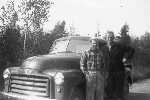 Siegfried Bruse and Hans-Joachim Roters in 1952.
[20]
Siegfried Bruse and Hans-Joachim Roters in 1952.
[20]
I came back to Canada for the large, empty spaces. There was also the feeling
that you could create something here, that you could achieve what you wished in
this land.
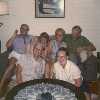
 At the Bruse residence in 1973.
At the Bruse residence in 1973.
Left picture: Front: Werner Lott and his wife Inge.
Back: Siegfried Bruse and his wife Ingelore, Adelheid
Grosser, Hans-Joachim "Jonny" Roters.
Right picture: Werner Lott,
Hans-Joachim "Jonny" Roters, Kurt Grosser,
Siegfried Bruse. [20]

 Siegfried Bruse on 14 August 1975.
Siegfried Bruse on 14 August 1975.
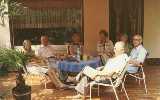 At the home of Gerhard Stamer in 1978. Clockwise from
left: Erika Bruse, Siegfried Bruse, Adelheid Grosser,
Irma Stamer, Ingelore Bruse, Gerhard Stamer,
Kurt Grosser. [20]
At the home of Gerhard Stamer in 1978. Clockwise from
left: Erika Bruse, Siegfried Bruse, Adelheid Grosser,
Irma Stamer, Ingelore Bruse, Gerhard Stamer,
Kurt Grosser. [20]
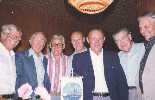 An unofficial reunion of some of the U-35 crewmembers in 1978. L-R:
Siegfried Bruse, Friedrich-Hermann Vollmer,
Peter von der Helm, Erich Bartold May,
Johann van der Pütten, Albert Schrader,
Gustav Horstkötter. [20]
An unofficial reunion of some of the U-35 crewmembers in 1978. L-R:
Siegfried Bruse, Friedrich-Hermann Vollmer,
Peter von der Helm, Erich Bartold May,
Johann van der Pütten, Albert Schrader,
Gustav Horstkötter. [20]
 At the Bruse residence in 1979: Seated, L-R: Irma Stamer, Dr.
Helmut Meyer (a fellow former POW), Hans-Joachim
Roters. Standing, L-R: Tony Kleimaker (a fellow former POW, and
business associate), Siegfried Bruse, Gerhard
Stamer. [20]
At the Bruse residence in 1979: Seated, L-R: Irma Stamer, Dr.
Helmut Meyer (a fellow former POW), Hans-Joachim
Roters. Standing, L-R: Tony Kleimaker (a fellow former POW, and
business associate), Siegfried Bruse, Gerhard
Stamer. [20]
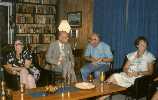 At the Bruse residence in 1979: Irma Stamer, Dr. Helmut Meyer
(a fellow former POW), Gerhard Stamer, Dr. Harda
Meyer. [20]
At the Bruse residence in 1979: Irma Stamer, Dr. Helmut Meyer
(a fellow former POW), Gerhard Stamer, Dr. Harda
Meyer. [20]
On the wall hangs a painting of U-35, which was a present to
Siegfried Bruse.
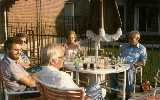 In Kitchener, Ontario, Canada in 1979: Clockwise from front:
Siegfried Bruse, Wolf-Dieter Kempf, Irma Stamer, [not yet
identified], Gerhard Stamer. [20]
In Kitchener, Ontario, Canada in 1979: Clockwise from front:
Siegfried Bruse, Wolf-Dieter Kempf, Irma Stamer, [not yet
identified], Gerhard Stamer. [20]
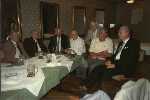 A reunion of the U-35 crew in May 1984 in Hamburg L-R: Martin Müller, Johannes
Weigand, Siegfried Bruse, Willi Jacob, Peter von der
Helm, Walter Roloff, Werner
Lott. [63]
A reunion of the U-35 crew in May 1984 in Hamburg L-R: Martin Müller, Johannes
Weigand, Siegfried Bruse, Willi Jacob, Peter von der
Helm, Walter Roloff, Werner
Lott. [63]
Siegfried Bruse retired in 1983. He passed away on 17 October 1996 and is
survived by his wife, Ingelore Bruse, and their two daughters and
families in Ontario, Canada. [19,20]
2018-10-18
URL: HTTP://WWW.U-35.COM
© 1999-2021 